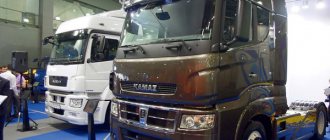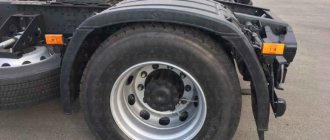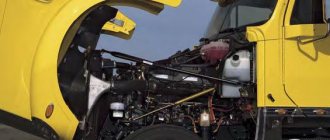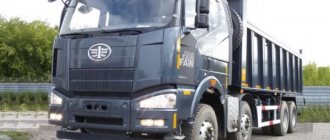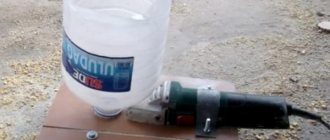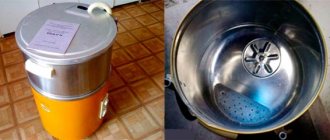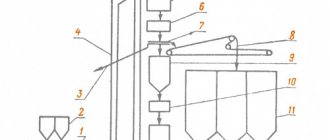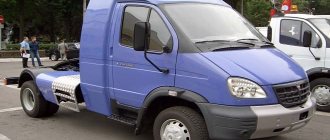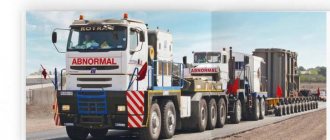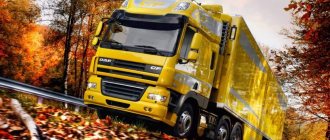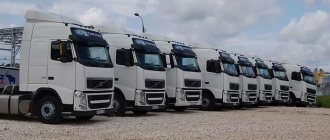The Russian automobile manufacturer presented a new generation of products to the domestic market - the powerful Ural Next machine, designed for extreme operating conditions. Trucks are assembled at Avtomobilny JSC, which is located in the city of Miass, Chelyabinsk region.
The first module was exhibited in 2014 in a local square. In 2015, at the Moscow exhibition of construction equipment, a model range of new Urals was shown, after which they went on sale.
Ridge
On the site of the Dmitrovsky Automotive Test Site there is a dump truck and a truck tractor - the basis of the entire future line of trucks, the most popular versions. The machines can be either with a short or long wheelbase, which makes it possible to use them in public utilities and farming, cargo transportation, and construction business. Externally, Urals 6x4 do not differ from all-wheel drive vehicles, but this is only at first glance. For road workers, we developed a new bottle-type frame with a width of 950 mm at the front and 770 mm at the rear. The design turned out to be more massive than that of all-wheel drive vehicles. The rear drive axles, as well as the front non-drive axle with a pronounced beam bend and a powerful stabilizer, are purchased from the Chinese company Shaanxi Hande Axle: the company does not yet have its own developments.
|
The rotation angle of the inner wheel has been increased to 50 degrees. That is, in terms of maneuverability, the Ural is comparable to a cabover truck. |
Dimensional parameters of a truck tractor
Despite the powerful engine, large load capacity and some design features (hood-type cab), the new truck tractor has relatively small overall characteristics.
This makes it quite easy to maneuver it while driving on the highway, as well as in the city:
- length from the radiator grill to the rear bumper – 8,050 mm;
- width from the right side mirror to the left – 2,500 mm;
- height from the wheel tread to the top of the cab roof is 3,195 mm.
Despite the rather impressive height of the cabin, which is a consequence of the presence of as many as two berths inside, driving under most engineering structures (bridges and the like) will not be a problem.
No resemblance other than appearance
Despite the outwardly similar associative image of the new generation Ural car, the clearly identifiable cabin rests on a completely different frame and axles than its “relatives” with a 6x6 wheel arrangement. The “gem” with a fifth-wheel coupling and a 6x4 wheel formula has a frame with a variable cross-section in width: 950 mm in the front and 770 mm in the rear. The thickness of the side members is 8 mm, the height is 280 mm, the maximum permissible total weight of the vehicle is 27.5 tons. The height of the fifth wheel coupling with the total weight of the road train is 1273 mm. The front suspension is dependent, of a traditional truck design: beam brand Shaanxi Hande Co. from China will accept a technically permissible load of up to 7500 kg. Rear 10-ton drive axles from the same Chinese manufacturer. The elastic elements of the suspension are solid springs - no hint of pneumatics. The cabin is attached to the frame very simply, using rubber-metal dampers. The power unit is an 11-liter YaMZ-653 (Euro 5) – the result of the development of the YaMZ-650, a Renault dCi 11 engine localized in Yaroslavl more than ten years ago, tuned to 420 hp and 2000 Nm of torque. That is why in the truck tractor it is paired with a mechanical 16-speed gearbox ZF 16 S2225 (Ecosplit model), designed for a maximum torque of up to 2225 Nm. In other gems of the Ural mine with the prefix “NEXT” in 2018, a 9-speed ZF gearbox of the Ecomid family was noticed, but that’s a completely different story... Technical characteristics of the Ural NEXT T25.420 6x4 truck tractor (7470-0005511-01)
| Permissible total weight of the road train, kg | 62 000 |
| Load on SSU, kg | 16 800 |
| Vehicle curb weight, kg | 9 200 |
| Axle load distribution, technically permissible, kg | 7500/ 10 000/10 000 |
Engine:
| 653.10, turbodiesel, I-6, Euro 5 11 122 422, at 1900 min - 1 1985 at 1100 -1300 min -1 |
Transmission:
| Mechanical, ZF 16 S2225 16/2 |
| Brake system | Pneumatic |
| Fuel tank capacity, l | 600 |
| Tires | 315/80 R22.5 |
| Suspension | Spring and spring-balanced |
| Maximum speed, km/h | 90 |
On the road!
“When driving out onto the road, look to the left, look to the right - is there a Soviet Urals somewhere?” - these words, they say, were repeated to each other by residents of the former GDR after a soldier in a truck ran over a tiny Trabant and did not notice it. There seemed to be no casualties. I’m sure this won’t happen with the new Ural: it has excellent visibility. True, if the asphalt is chipped, the mirrors on their long legs dangle a little. This is a minus of the unified cabin, which is very narrow.
The dump truck has a 328-horsepower Euro-5 eco-class diesel engine (that’s why a 39-liter AdBlue urea tank was placed on the starboard side) and a 9-speed ZF manual transmission. Using the joystick is a pleasure: good selectivity, small moves, literally like a car. True, you have to switch based on the sound of the engine, because the tachometer does not have a red zone marked. There are no complaints about the brakes either; they grip tenaciously. By the way, on all axes there are drum machines with pneumatic drive. At first I thought that it would be difficult to work with a GAZelle steering wheel on a truck, but my doubts were dispelled. The steering wheel turns easily, the Ural steers, I would even say sharply. All reactions are predictable - whether on asphalt or when maneuvering on a dirt road.
|
|
We can handle the slopes!
The most important difference between the Ural NEXT family truck tractor and its fellow tribesmen is not the fifth wheel coupling or even the extended cab, but the engine. "Ural NEXT" model 7470-0005511-01 received the YaMZ-653 engine. The fact is that for the declared total weight of a road train of up to 62 tons, an engine with a working volume of 6.7 liters will not be enough, no matter how much the power settings are inflated. The alternative 11-liter engine, the heir to the 650 family, “plays” in the fifth environmental class, demonstrating 420-horsepower muscles and 2000 Nm of torque. Unfortunately, this is not very much, but so far the GAZ group does not have a more powerful engine of its own production, and besides, car manufacturers do not want the inevitable increase in the cost of equipment when using purchased units outside the GAZ group. However, with a rational selection of gear ratios in the transmission, the most necessary and sufficient condition for power availability is met.
A series of tests on prolonged slopes of up to 10% confirmed the performance of our hitch, but the driver is required to minimize errors in selecting gears and planning preliminary accelerations, and remember to use the roll-up effectively. The engine retarder copes with its duties quite well, but the miniature button for turning it on at the end of the steering column switch is not very convenient - you need to look for it visually and tactilely... The road train has good maneuverability due to the fact that when turning, the inner wheel of the front steered axle can deviate by an angle of up to 50º , external - up to 32º: the experiment with a narrow shift and a negative turn did not cause any difficulties, with such a considerable total overall length of the hitch with a four-axle semi-trailer!
Dump truck "URAL NEXT S25.330"
The dump truck is designed for transportation of various bulk construction and industrial cargo on roads from the first to fourth categories at ambient temperatures from –45 to +40 °C. The load capacity of the dump truck is 14,500 kg when driving on public roads or 16,000 kg is structurally permissible, the volume of the dump platform is 14 m3. The power unit consists of a YaMZ-536 engine of the fifth environmental class with increased power since 2015: 330 hp versus 312 two years earlier, and torque has also increased to 1370 Nm (in 2015 it was 1240 Nm). The gearbox is mechanical, 9-speed ZF model 9S 1515. The gear shift drive is now cable, and the compact lever is located in the front panel and does not interfere with passengers.
Torque and confident, but not fast
A four-axle flatbed semi-trailer TONAR-974614, with a technically permissible gross weight of 55 tons, was selected to pair the truck tractor and ballasted with 23 tons of foundation blocks. The creators of this transport immediately drew attention to the fact that they were building a truck tractor with double tires on the drive axles, capable of moving “with the breeze” at a speed of up to 90 km/h and having a comfortable cabin - this equipment is not intended for long-haul transportation. Our hard worker “Ural-NEXT 6x4 T25.422 (7470-0005511-01)” is the main character of the construction site, deposit, mine, forest plot. Its second half is a dump semi-trailer, a pipe carrier, a tank, a log carrier, a dismantling truck, a trawl, probably all of the listed semi-trailers with extraordinary wheel designs and other interesting axle solutions, but this is definitely not a lightweight “awning” for “international” traffic or an express mail van. delivery.
For practical acquaintance with the original road train, we were prepared with several slopes with a steepness of 6 to 10%, a section of a network of asphalt roads and some forest and dirt roads with minor washouts.
Steering system
This unit consists of the following components:
- steering column;
- mechanism;
- drive;
- hydraulic booster (power steering).
Different types of control are used on different modifications of truck tractors:
– screw – nut (ball) – rack – sector;
- worm - side sector.
The column is connected to the steering mechanism using cardans and an intermediate support. The latter has closed-type bearings that do not require lubrication, which facilitates their operation.
The lineup
A couple of variations. The Next family lineup includes two tractors on a 6 × 6 chassis and one on a 6 × 4 chassis.
Let's take a closer look at their technical characteristics.
44202-5311-74
Features of tractors:
- chassis formula – 6 × 6;
- maximum pressure on the fifth wheel coupling mechanism – 12 t;
- maximum permissible total trailer weight – 29 tons;
- fifth wheel height – 1450–1490 mm;
- The engine used is YaMZ-53602-10 with 6 cylinders and a power of 312 hp. With.;
- 9-speed gearbox type ZF-9S1310T0;
- tires type 425/85 R21;
- fuel capacity 300 + 180 l.
44202-5311-74e5
The model uses a similar engine with the same number of cylinders and their arrangement.
The machine is more modified and contains a couple of additional functions:
- pneumatic drives influencing the parking brake and gearbox;
- function of blocking the center and cross-axle differential;
- built-in ABS;
- car radio type 2 DIN;
- navigation system "Era-Glonass";
- Electrically heated windshield and mirrors in the cabin.
Gear box
All modifications of the tractor in question use the YaMZ-239 gearbox.
It is mechanical and has 9 gears. This makes it easy to select the desired driving mode depending on the cargo being transported, as well as road conditions (ice, mud).
This type of gearbox is equipped with a dual-range planetary deduplicator.
The synchronizer is available in all gears, excluding first and reverse. This makes it possible to perform all shifts with maximum comfort.
The box is controlled using a special lever; it is attached by a remote drive to the connecting shaft located on the left side of the box.
Important! Switching off or changing gears is done using a special pneumatic mechanism. When switching, the lower gear range is blocked.
The cardan shaft is secured with a special flange made of high-strength alloy steel, which has a long service life. Therefore, the truck can easily withstand even long-term extreme operating conditions.
There is a possibility of placing a power take-off shaft on the box. It can be of two types:
- selection is carried out from the gear ring of the intermediate shaft (up to 100 hp);
- from the spur gear of the intermediate shaft through the hatch located on the side of the box body (40 hp).
Thus, if necessary, Ural-6464 can be equipped with any additional equipment to perform non-standard tasks. The clutch housing is filled with oil, the normal amount of which is 11.5 liters.
Options
The 6x4 tractor is available in a single basic configuration, which includes the following options:
- Locking the cross-axle differential of the middle and rear axle
- Center differential lock
- Anti-lock braking system (ABS)
- Engine preheater
- 2DIN multimedia with steering wheel controls, USB
- Daytime running lights (DRL)
- Fog lights
- Electrically heated mirrors
- Electrically heated windshield
- Electric windows
- Autonomous cabin heater
- Electric heating of fuel filters
- Electric heating of the fuel intake
- central locking
- Driver's seat with air suspension
- Multifunctional steering wheel
- Cruise control
- USB charging port
- Fire extinguisher
- Tachograph
- System "ERA-GLONASS"
Clear work, but with a peculiarity...
We start, pump air, and get underway. The 16-speed gearbox ZF 16 S2225 Ecosplit - a long-liver in production and a regular at the most international parties of automakers - needs no introduction. She took the gear shift algorithm with her from the floor lever with a rocker and embodied it in a cable drive of a compact lever on the console in the center of the panel. The lower row named “turtle” with its own neutral tilts the lever to the left, the “bunny” space tilts the control to the right (by the way, a very useful indication of the rows and neutral has appeared on the instrument cluster), the “halves” control flag traditionally resembles an “Adam’s apple”.
Even the presence of 23 tons of ballast in the semi-trailer when starting off on smooth asphalt does not require selecting a low gear. I start with II, stop, and try again with III. Everything works, the clutch closing moment is adequate, there are no jolts or choking, characteristic of a lack of torque at the bottom. I accelerate, move to the top row, there is still a small rise ahead (not calibrated, we’re just driving through the territory of the test site), there’s clearly no need to switch lower, but I want to raise the engine speed a little before the slope. I prepare for “half” down by moving the divider flag, then briefly depress the clutch, and immediately receive a noticeable push in the transmission. It turns out that here the switching of the flag is carried out strictly simultaneously with squeezing the clutch. Nothing complicated, but you need to remember this feature, because it’s “not like everyone else”!
Service
A trucker's engine, like no other, needs regular maintenance; its trouble-free operation depends on proper maintenance. Hood tractors feature full access to the engine compartment and to all devices located under the hood. Thus, on the road you can make most of the simple adjustments, top up the lubricant reservoirs to the required level, and tighten connections.
The car's hood opens forward in the direction of travel using a powerful pneumatic lifting device. No additional effort on the part of the driver is required. Three-stage ladders on both sides of the tractor allow you to reach the most inaccessible points of the engine compartment and perform the necessary actions.
Almost a masterpiece of convenience and practicality
The Ural brand truck itself, albeit of the NEXT generation, but not on “laptozhny” tires and without front drive wheels, is perceived at least as interesting, and there are no parallels with the Ural-377 model, half-forgotten by the masses. Adding to the intrigue is a long cabin with a “sleeping bag”, in the air-conditioned coolness of which the sun’s rays penetrate through the tinted glass of the roof hatch. I’m slowly getting to know each other and getting used to it.
Here is the appearance of the familiar workplace of the unified cabin module of the GAZ group. I lament that, again, they haven’t marked out the tachometer speed zones, but, of course, I’m pleased with the long-awaited compact joystick lever for the manual transmission in the front panel. Unlike the Ural and Nizhny Novgorod “single” cabs, there are two equivalent shock-absorbing solid chairs: for the driver and passenger instead of the right double sofa. The driver has two options for accessing the rest area: you can use the short path between the seats, leading to the berth without leaving the cabin, or through the rear right door, which directly leads to the rest area, but for this you will have to go outside.
The Ural inherited this design solution from the double-row cab of Nizhny Novgorod trucks, but in Miass, instead of seats, a wide sleeping shelf spanning the entire width of the cab was designed and fitted into this space. Therefore, if you open the rear door, you can see that the inner step is blocked by the “bed” plane. Factory workers say that this door will be abandoned in mass production. It’s a pity, because if you conjure a little more with the space, you can simply create a masterpiece of convenience and practicality, for example, if you optimize the cavities under the sleeping shelf with the help of niches, shelves and closed boxes, you can even fit a refrigerator in there. In general, the cabin already has a good set of additional equipment: air conditioning, heating and ventilation system with an air filter, electrically heated windshield and mirrors, multifunction steering wheel, cruise control, pre-heater, tachograph, central locking and even a good audio system with a “double-din” head unit and color display.
The berth in a truck tractor is somewhat unusual due to the unification of the cabin module; it has its own exit
Dashboard
The following sensors are located on the dashboard located in front of the driver:
- a tachometer that accurately reflects data on changes in torque;
- speedometer with a scale from 20 to 160 km/h;
- oil temperature sensor in the crankcase, outside the pressure system;
- fuel level in the gas tank;
- battery charging sensor;
- oil pressure and temperature in the main system.
In a separate section of the dashboard there are:
- high and low beam switches;
- heating system control;
- rheostats for heating exterior rear-view mirrors;
- remote control of air conditioning and ventilation;
- emergency stop switch;
- audio system control buttons operating in two modes, remote and direct.
